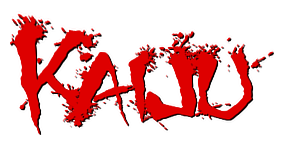


Name:
Hidoikami taniwha | "Taniwha" | "Moho"
Appearance:
Taniwha's skin is a dark, charcoal gray, with a pale underbelly. Armor plates are black, and often described akin to obsidian. When angered, the skin around the plates and fins glow red. Taniwha also lacks teeth; what some would identify as teeth are actually blade-like, self-sharpening parts of the skull.
Size:
Taniwha is on the smaller end of the kaiju spectrum, at an estimated 25 meters at the hip, and 75 meters in length. Despite this, its bones are incredibly dense, and make it heavier than most monsters of a similar size.
First Appearance:
Shortly after the ultrasonic pulse, vessels began disappearing near White Island, New Zealand. The attacks began occurring closer and closer to land until Taniwha made landfall in Auckland.
Abilities:
Powerful jaws— Taniwha possesses jaws powerful enough to crush both stone and metal.
Heat tolerance— Shows enough resistance to magma and lava to burrow through it and store small amounts in its body.
Burrowing— Though by no means amazing, Taniwha can burrow through earth, magma, and lava; this is partly accomplished by chewing the material.
Magma spit— Taniwha has a special organ in its body (theorized to be in the chest, near the base of the neck) to store molten magma or lava, and maintain its temperature. In dire situations, it spits magma as a last resort.
Amphibious biology— Possesses gills and lungs.
Durability— Its skeletal structure makes Taniwha extremely resistant to ballistic weaponry.
Weaknesses:
Cold temperatures— Taniwha is unable to withstand temperatures below freezing. It's theorized that temperatures below freezing interferes with its ability to maintain magma in a liquid state in its body.
Weak lungs— Taniwha's lungs are quite weak, and the monster must return to the water for a period of time.
Gills— Taniwha's gills are nearly unarmored, and contain a large amount of nerves and blood vessels.
Electricity— Powerful electromagnetic fields may deter, stun, or confuse Taniwha.
Pollution— Taniwha avoids heavily polluted waters.
Display of force— Given its size in comparison to other monsters, a sufficient threat display from an opponent may make Taniwha flee.
Personality:
In the past, Taniwha was regarded as a guardian spirit by the Maori people. However, after it came ashore and rampaged through Auckland, it has maintained a low profile, and has had very few interactions with humans since then.
History:
Tales of giant sharks have been part of Oceania mythology for centuries, as both a benevolent and destructive force. The first modern account of this monster was from a Japanese destroyer in 1942. The officer in charge described it as a "terrible god" in his report, which remained classified until it was sighted again by TERRA in 2016. It wasn't until 2021 that more information was gleaned from its biology, when it made landfall to attack Auckland. Since then, it has maintained a low profile, traveling along the Pacific rim.
Other:
— Taniwha displays physical traits akin to the extinct Dunkleosteus; biologists in TERRA are unable to agree if the resemblance is a case of evolutionary convergence or if Taniwha is descended from these prehistoric fish.
Theme:
Lord of the Depths


Name:
Gigouroboros midgardi | Jörmungandr | Midgard Serpent | World Serpent
Appearance:
A massive serpent with traits of other reptilians, namely osteoderms and scutes embedded in the skin. Scans of the serpent while dormant, and ancient remains of a deceased individual indicate the presence of vestigial hind and forelimbs.
Size:
Estimated to be between 91.44 and 152.4 meters in length.
First Appearance:
Escaped from Outpost 54 (located on the island of Jan Mayen), and came ashore in Bodø, Norway. A deceased specimen has been in TERRA's possession since 2010 after being unearthed in Sápmi, near the coast of the Norwegian Sea.
Abilities:
Venom- Jörmungandr possesses a corrosive venom. It can be spat or delivered in a bite in liquid form, or sprayed as a mist. It is also immune or resistant to most forms of biological toxins.
Thick hide- Thanks to the scutes and osteoderms in its skin, the monster is well protected against most man-portable weapons.
Cold resistance- Jörmungandr is quite comfortable in the freezing waters of the North Atlantic.
Swimming & burrowing- Jörmungandr is an adept swimmer and burrower, though not exceptionally fast.
Weaknesses:
Electricity- Jörmungandr shows an aversion to strong electromagnetic fields; despite this, it is drawn towards smaller electrical fields.
Oxygen- Unlike most monsters associated with the depths, Jörmungandr cannot stay underwater indefinitely.
Weight- Due to its size, the beast is quite slow.
Personality:
Aggressive, though not necessarily malevolent. Its attacks so far seem to have been driven primarily by hunger.
History:
Encounters with Jörmungandr date back to the eleventh century, where the great serpent in the sea was stated to be destined to fight the Norse god Thor. Scientists at TERRA theorize that sightings of massive serpents in the North Atlantic may have been the Midgard Serpent waking up for a "midnight snack" before returning to its slumber. In 1961, the great serpent's resting place was discovered in a cavern beneath Jan Mayen, and after it was determined that the monster was dormant (a state known as "brumation", to be precise) and not dead, a facility was built to study the creature. This lasted for decades... until the beast woke, destroyed the outpost, and made its way to Norwegian waters.
Theme:
Thorsbane




Name:
Emiko Martin
Appearance:
Emiko appears younger than she really is, though is often covered with grease and oil. She's slightly shorter than most young women her age (149.86 cm). Emiko has a distinct scar on her right hand.
Age:
20 years (DOB— June 6, 2001)
Occupation:
College student, part-time mechanic
Starting Location:
Hakata-ku, Fukuoka, Japan
History:
Born and raised in Yokohama, Emiko's father served in the US Navy, and was stationed in Japan when he met his (now ex-) wife, an evolutionary biologist in the employ of TERRA. Growing up, Emiko didn't see her mother much, and when her father retired from the Navy, he took a job covering foreign stories at a news station. Emiko always had a knack for machines, and electronics, to a lesser extent. After high school, she began studying mechanical engineering.
Other:
Blood type: B-
Has a fondness for animals, especially reptiles
Can often be found listening to almost anything, and is rarely without a pair of beat-up headphones
Not picky about fashion, with her main criteria being comfort and ease of movement
Eats a surprising amount for someone of her size


